300 Endangered Humpback Chub Translocated to Shinumo Creekby Meredith Hartwell, Science Communication and Outreach Program Intern, 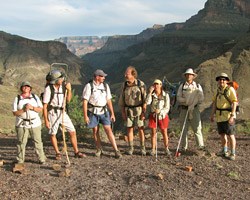
NPS PHOTO BY MEREDITH HARTWELL June 2009 marked an important point in the conservation of a rare species of fish in Grand Canyon National Park. Mid-month, during unusually mild and cloudy weather, fifteen biologists and field crew members from several agencies hiked down Bright Angel Trail to Phantom Ranch, then traveled approximately 20 miles downstream by NPS raft to Upper Bass Camp. Once there, the crew took critical steps in a collaborative, multi-agency effort to establish a second satellite population of endangered humpback chub (Gila cypha) in Grand Canyon with the translocation of three hundred young chub into the clear waters of Shinumo Creek, a tributary that meets the Colorado River at River Mile 109. Humpback Chub (Gila cypha)
The humpback chub (Gila cypha) is an endemic species to the Colorado River basin. Once widely distributed throughout most of the Colorado River basin, just six populations are now found within the Colorado River system, with five in the upper part of the basin. The largest population is found at the confluence of the Little Colorado and Colorado Rivers in Grand Canyon. One of the management goals for Glen Canyon Dam operation is to maintain or attain viable populations of existing native fish in Grand Canyon. In recent years, biologists have undertaken many conservation measures aimed at conserving humpback chub populations in Grand Canyon, including translocating humpback chub into previously unoccupied habitat in the Little Colorado River above Chute Falls. Establishing a second satellite population in another Grand Canyon tributary is critical, so that in the chance of a catastrophic event, such as a hazardous material spill into the Little Colorado River, the wild populations of humpback chub in Grand Canyon National Park are not lost. Shinumo Creek
NPS PHOTO BY MEREDITH HARTWELL Shinumo Creek is suitable for humpback chub for variety of reasons: it has temperatures that range within the requirements for young chub to grow large enough to resist predation by non-native fish, dense vegetation grows along its banks, it contains a sufficient foodbase of invertebrates, there are low levels of non-native predatory fish, and a barrier falls prevents non-native fish from migrating from the Colorado River upstream to the release sites. June's translocation field crew was composed of fisheries biologists from the National Park Service, U.S. Fish and Wildlife Service, Bureau of Reclamation, Grand Canyon Wildlands Council, and Arizona Game and Fish Department and volunteers. Each morning for a week, the group hiked the steep trail from their camp along the Colorado River to a section of Shinumo Creek a few miles from the river to prepare for the upcoming translocation. The crew surveyed existing fish populations and removed non-native rainbow trout in the reaches of Shinumo Creek with appropriate humpback chub habitat using electrofishing, hoop netting, and seining (netting) techniques. These sampling methods repeated those used in earlier studies and in May 2009 to collect base-line data on Shinumo Creek fish populations. Future surveys will assess whether the translocated humpback chub population survives, thrives and ultimately grows. Grand Canyon National Park fisheries biologist Brian Healy said, “The Shinumo Creek translocation project is a vital step in expanding humpback chub populations throughout Grand Canyon and in conserving the species.” Electrofishing
NPS PHOTO BY MEREDITH HARTWELL 
NPS PHOTO BY MEREDITH HARTWELL Over the course of several days, the crew made repeated electrofishing passes, and used hoop nets and seines in the stream reach where the humpback chub would be released. More than 800 rainbow trout were removed from the translocation reach in June and during previous field work in May in order to minimize the chance that the young chub would become prey, and also to reduce competition for food resources. PIT Tag Antenna Installation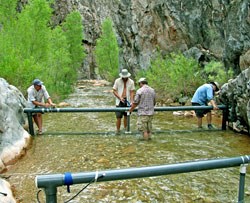
NPS PHOTO BY MEREDITH HARTWELL In addition to electrofishing and seining, a stream gage and two PIT (passive integrated transponder) tag antennas were installed parallel to each other just above the barrier falls, well downstream from the chub release sites. 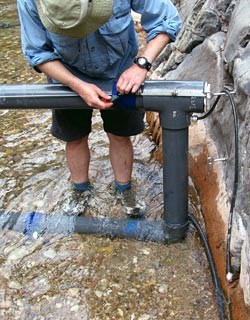
NPS PHOTO BY MEREDITH HARTWELL The antennas contain PIT tag sensors within large tubes. The tubes each form a rectangular structure with a supporting “T” post. The structures sit in the base of the stream bed, and are secured across its width, anchored firmly to rock faces on the banks, and into the stream bedrock. Cables run from each antenna detector to a system that was constructed against the canyon wall, high up on the stream bank and protected from high flows. The system records the unique PIT tag number for each individual fish, the exact time, and the direction the fish was swimming when it crosses the sensors. 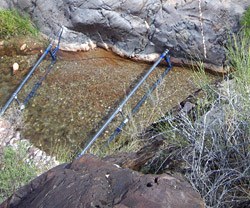
NPS PHOTO BY MELISSA TRAMMELL The PIT tag antenna, in conjunction with the stream gage, will allow biologists to determine if humpback chub are washed out of the creek because of monsoonal flooding. Translocation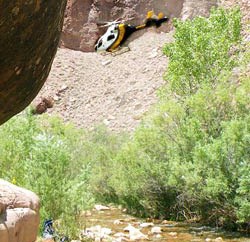
NPS PHOTO BY MELISSA TRAMMELL While their flight from the South Rim was short, their overall journey was a long one. It started with their capture from the Little Colorado River in July and October 2008. From there they were taken to the AZ Game and Fish Department Bubbling Ponds Fish Hatchery for parasite treatment for a month. Then the chub were transferred to Dexter National Fish Hatchery in New Mexico, where they spent the winter. 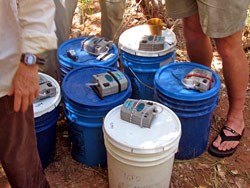
NPS PHOTO BY MEREDITH HARTWELL Four sites in Shinumo Creek were selected as ideal release locations, but first, well-planned procedures to accustom the fish to their new home had to take place. The crew took care to avoid subjecting the fish to unnecessary stress during the entire translocation process. Right after landing, the fish were carefully removed with hand-held nets from the coolers to buckets containing water from the hatchery. 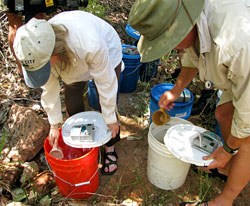
NPS PHOTO BY MEREDITH HARTWELL The buckets were fitted with aerators to keep the water cool and oxygenated, and were immediately moved to shady areas along the stream bank directly adjacent to the sites where the humpback chub would be released. Then, a slow tempering process took place by which, cup by cup, hatchery water from the buckets was removed and replaced by Shinumo Creek water. The tempering took about an hour, so that the hatchery water was slowly diluted, and the fish became acclimatized to creek conditions. After tempering, each bucket was carried into the creek, gradually tilted into the water, and the fish swam out into their big new world. 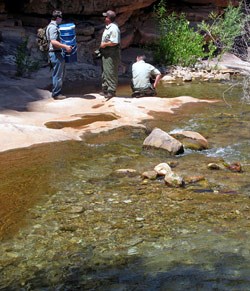
NPS PHOTO BY MEREDITH HARTWELL Each of the four release sites were adjacent to one another. One of the sites was in a large pool with a small waterfall, two were slightly upstream of the pool, and one was slightly downstream. The release was highly successful, with no mortality or injury to any of the humpback chub. The young chub started to feed immediately, and the biologists noted that no visible stress was observed in the fish; both good signs that all had gone smoothly. Future Work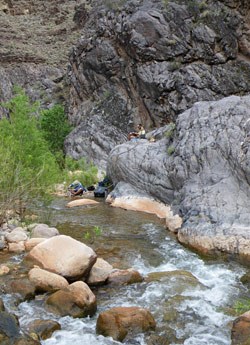
NPS PHOTO BY MELISSA TRAMMELL This project will, over time, enable biologists to assess how humpback chub adapt to Shinumo Creek and whether a population can become established there. Biologists will continue to monitor the humpback chub population in Shinumo Creek and determine if there is any evidence of reproduction. Even if a reproducing population of humpback chub does not become established in Shinumo Creek, fish dispersing out of the creek may augment existing aggregations in the Colorado River, which would also benefit conservation efforts for the species. Related Information To learn more about the Shinumo Creek humpback chub translocation project:
|
Last updated: February 24, 2015
